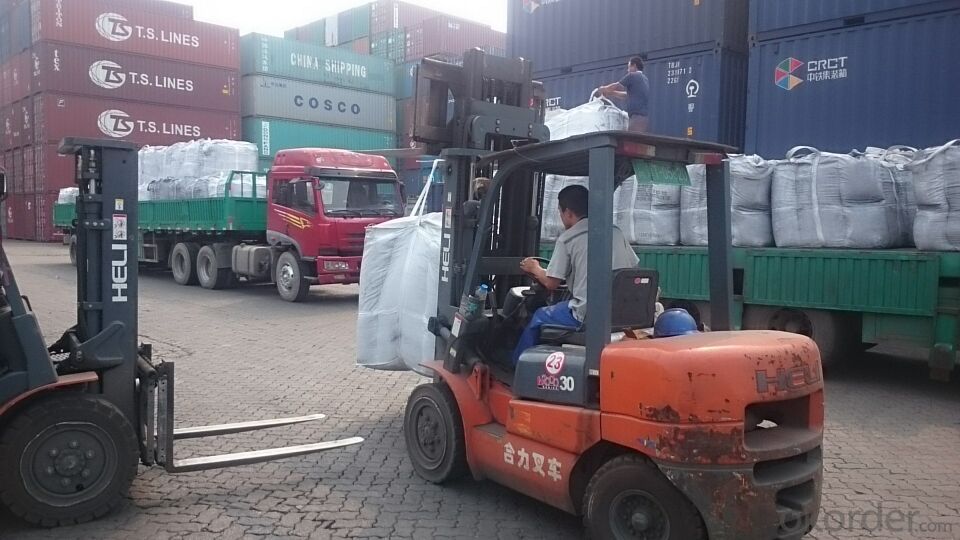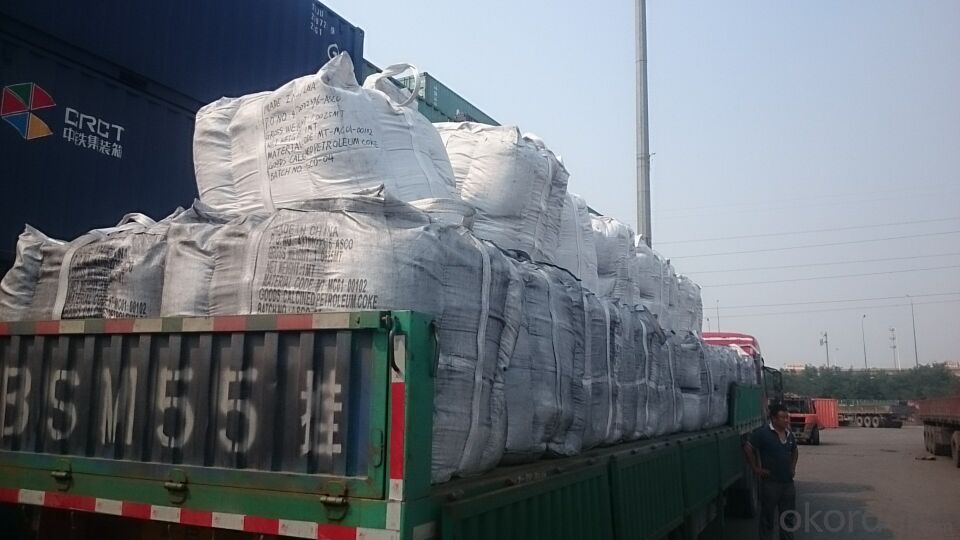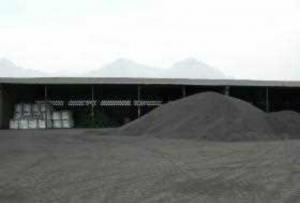GPC with lower Sulphur0.03% max in Low Ash
- Loading Port:
- Qingdao
- Payment Terms:
- TT OR LC
- Min Order Qty:
- 24 m.t.
- Supply Capability:
- 5004 m.t./month
OKorder Service Pledge
OKorder Financial Service
You Might Also Like
Introduction:
it is playing more and more important role in the industryGPC has good characteristics with low ash, low resistivity, low sulphur, high carbon and high density. It is the best material for high quality carbon products. It is used as carbon additive in steel industry or fuel.
Features:
1.Our strong team provide you reliable service that make you feel purchasing is more easier
4. Highest standard of integrity. Guarantee customer's benefit.
5. Supplying Pet Coke, Met coke, Foundry Coke, Carbon Raiser etc.
Specifications:
F.C.% | 95MIN | 94MIN | 93MIN | 92MIN | 90MIN | 85MIN | 84MIN |
ASH % | 4MAX | 5MAX | 6 MAX | 6.5MAX | 8.5MAX | 12MAX | 13MAX |
V.M.% | 1 MAX | 1MAX | 1.0MAX | 1.5MAX | 1.5MAX | 3 MAX | 3 MAX |
SULFUR % | 0.3MAX | 0.3MAX | 0.3MAX | 0.35MAX | 0.35MAX | 0.5MAX | 0.5MAX |
MOISTURE % | 0.5MAX | 0.5MAX | 0.5MAX | 0.5MAX | 0.5MAX | 1MAX | 1MAX |
Pictures



FAQ:
1. Your specification is not very suitable for us.
Please offer us specific indicators by TM or email. We will give you feedback as soon as possible.
3. Do you provide samples?
Yes, samples are available for you to check our quality.
Samples delivery time will be about 3-10 days.
4. What about the lead time for mass product?
The lead time is based on the quantity, about 7-15 days. For graphite product, apply Dual-use items license need about 15-20 working days.
5. What is your terms of delivery?
We accept FOB, CFR, CIF, EXW, etc. You can choose the most convenient way for you. Besides that,
we can also shipping by Air and Express.
6. Product packaging?
We are packed in bulk ship or in ton bag or placing in container or according to your requirements.
7. Notice
please note that the price on Alibaba is a rough price. The actual price will depends on raw materials, exchange rate wage and your order quantity .Hope to cooperation with you, thanks !
- Q:How does carbon contribute to the strength of concrete?
- Carbon contributes to the strength of concrete by reinforcing it through the formation of calcium silicate hydrate (C-S-H) gel. This gel fills in the gaps in the concrete matrix, enhancing its density and reducing porosity. Additionally, the carbonaceous material reacts with calcium hydroxide (a byproduct of cement hydration), producing calcium carbonate. The formation of calcium carbonate increases the overall strength and durability of the concrete structure.
- Q:What are the impacts of carbon emissions on ecosystems?
- Ecosystems are significantly affected by carbon emissions, and their consequences can be observed at various levels of the food chain. One of the primary effects is the modification of the climate, as carbon emissions contribute to global warming and climate change. This alteration in temperature and weather patterns can disturb ecosystems and result in the depletion of biodiversity. Moreover, increased carbon emissions also play a role in ocean acidification, a process in which seawater absorbs carbon dioxide, leading to a reduction in pH levels. This can have harmful impacts on marine life, especially organisms that possess calcium carbonate shells like corals, mollusks, and specific plankton species. As the acidity of the oceans intensifies, it becomes more difficult for these organisms to produce and maintain their protective shells, ultimately causing a decline in their populations. Additionally, carbon emissions have the potential to influence the distribution and behavior of species. With rising temperatures, certain habitats become unsuitable for some species, compelling them to either migrate or adapt to new conditions. This can disrupt the fragile equilibrium of ecosystems, as some species may struggle to find sufficient resources or face heightened competition for limited resources in their new environments. Furthermore, carbon emissions have a significant impact on the frequency and intensity of extreme weather events such as hurricanes, droughts, and wildfires. These occurrences can result in the destruction of habitats, loss of vegetation, and displacement of species, ultimately affecting the overall well-being and stability of ecosystems. In conclusion, the effects of carbon emissions on ecosystems are profound and far-reaching. It is imperative to reduce these emissions and transition to cleaner sources of energy in order to mitigate these consequences and safeguard the delicate balance of our natural world.
- Q:Is carbon a metal or non-metal?
- Located in group 14 of the periodic table, carbon is classified as a non-metal. Contrary to metals, non-metals possess properties that are typically the opposite, such as poor conductivity of heat and electricity, low melting and boiling points, and brittleness. Carbon, in particular, is renowned for its capacity to generate an array of allotropes, notably graphite and diamond. Although these allotropes exhibit distinct physical and chemical traits, they all share the common attribute of being non-metals.
- Q:How do carbon emissions contribute to extreme weather events?
- Extreme weather events are influenced by carbon emissions, which contribute to climate change. When greenhouse gases like carbon dioxide are released into the atmosphere, they trap heat from the sun and cause the Earth's average temperature to rise. Human activities such as burning fossil fuels, deforestation, and industrial processes are major drivers of this phenomenon known as global warming. As the planet warms, weather patterns become disrupted, leading to an increase in extreme weather events. Carbon emissions play a role in this process in several ways: 1. Heatwaves: Higher carbon emissions result in increased temperatures, leading to more frequent and intense heatwaves. These prolonged periods of extreme heat pose risks to human health, agriculture, and ecosystems. 2. Hurricanes and tropical storms: Carbon emissions cause ocean temperatures to rise, providing more energy to fuel hurricanes and tropical storms. This leads to stronger storms with higher wind speeds and heavier rainfall, causing more destruction and flooding. 3. Droughts: Climate change caused by carbon emissions can disrupt precipitation patterns, resulting in decreased rainfall and increased droughts in certain regions. These prolonged periods of water scarcity have severe impacts on agriculture, water supplies, and ecosystems. 4. Heavy rainfall and flooding: Global warming intensifies the water cycle, leading to more evaporation and moisture in the atmosphere. This results in heavier rainfall events, increasing the risk of flooding and flash floods. 5. Wildfires: Climate change, driven by rising temperatures and drier conditions, creates favorable conditions for wildfires. Carbon emissions contribute to longer and more severe fire seasons, leading to more extensive and destructive wildfires. It's important to note that while carbon emissions contribute to extreme weather events, they are not the sole cause. Natural climate variability factors like El Niño and La Niña can also influence extreme weather. However, reducing carbon emissions and transitioning to cleaner energy sources can help mitigate the impacts of climate change and prevent further exacerbation of extreme weather events.
- Q:What is the role of carbon in the formation of fossil fuels?
- The role of carbon in the formation of fossil fuels is crucial. Fossil fuels, such as coal, oil, and natural gas, are formed from the remains of ancient plants and organisms that lived millions of years ago. These organisms were primarily made up of carbon-based compounds. Over time, the organic matter accumulated and was buried under layers of sediment, subjected to intense heat and pressure. This process, known as carbonization, caused the carbon within the organic matter to undergo chemical changes, transforming it into fossil fuels. Therefore, carbon is the key element involved in the formation of fossil fuels.
- Q:What is the structure of carbon-based polymers?
- The structure of carbon-based polymers is characterized by a chain-like arrangement of carbon atoms, forming the backbone of the polymer. These carbon atoms are typically bonded to other atoms or groups of atoms, such as hydrogen, oxygen, nitrogen, or halogens, through covalent bonds. The properties of the polymer are determined by the arrangement and connectivity of these atoms. In addition to the carbon backbone, functional groups are often present in carbon-based polymers. These functional groups are specific combinations of atoms that can give the polymer unique chemical properties. They can be attached to different points along the carbon backbone, adding chemical diversity and altering the behavior of the polymer. The monomers, which are the repeating units in carbon-based polymers, can vary in size and complexity. For instance, simple hydrocarbons like ethylene can undergo polymerization to form polyethylene, which consists of a long chain of carbon atoms with attached hydrogen atoms. On the other hand, more complex monomers like acrylonitrile or styrene can be utilized to produce polymers like polyacrylonitrile or polystyrene, respectively. These polymers incorporate additional atoms or functional groups, resulting in distinct properties and applications. In conclusion, carbon-based polymers possess a diverse structure that can be customized to fulfill specific requirements. This versatility allows them to be utilized in a wide array of industries, including plastics, textiles, and electronics.
- Q:What is the starting temperature and final forging temperature of carbon steel?
- The forging temperature range should be as wide as possible, to reduce forging times, improve productivity.1. initial forging temperatureInitial forging temperature is blank began forging temperature should be understood as the highest heating temperature allows steel or alloy in the heating furnace. The furnace before removing from the blank to the forging equipment to forging blank, blank size according to the delivery method and heating furnace and forging a distance between the equipment, there are a few blank tens of degrees of temperature drop. Therefore, really began forging a low temperature, the initial forging blank before, should try to reduce the temperature drop.
- Q:How does carbon impact the prevalence of tsunamis?
- Carbon dioxide does not directly impact the prevalence of tsunamis. Tsunamis are primarily caused by undersea earthquakes, volcanic eruptions, or underwater landslides. These events release massive amounts of energy into the water, generating powerful waves that can travel across the ocean and cause devastating destruction when they reach the coast. While carbon dioxide emissions do not directly cause tsunamis, they are linked to climate change, which can indirectly influence the occurrence and impact of these natural disasters. Increased levels of carbon dioxide and other greenhouse gases in the atmosphere contribute to global warming, resulting in rising sea levels. As sea levels rise, coastal areas become more vulnerable to the destructive power of tsunamis, as the waves can penetrate further inland. Furthermore, climate change can also affect the frequency and intensity of extreme weather events, such as hurricanes and tropical storms. These weather patterns can trigger underwater landslides or enhance the chances of volcanic eruptions, both of which can lead to tsunamis. In conclusion, while carbon dioxide emissions do not directly cause tsunamis, they play a role in the broader context of climate change, which can indirectly impact the prevalence and impact of tsunamis through rising sea levels and the potential for more frequent extreme weather events.
- Q:What is carbon neutral manufacturing?
- Carbon neutral manufacturing refers to the process of manufacturing goods while minimizing or offsetting the carbon emissions associated with the production. It involves reducing greenhouse gas emissions at every stage of the manufacturing process, from sourcing raw materials to the disposal of finished products. This can be achieved through various measures such as energy efficiency, the use of renewable energy sources, implementing sustainable practices, and investing in carbon offset projects. To become carbon neutral, manufacturers typically start by conducting a detailed assessment of their carbon footprint, which involves identifying and quantifying all the emissions generated in their operations. This includes direct emissions from manufacturing processes, as well as indirect emissions from the energy sources they use. Once the emissions are measured, manufacturers can develop strategies to reduce their carbon footprint. Some common methods of achieving carbon neutrality in manufacturing include optimizing energy consumption by using efficient equipment and technologies, adopting renewable energy sources like solar or wind power, and implementing waste reduction and recycling programs. Additionally, manufacturers can invest in carbon offset projects, which are initiatives that reduce or remove greenhouse gas emissions from the atmosphere, such as reforestation or renewable energy projects. By implementing these measures and offsetting any remaining emissions, manufacturers can achieve carbon neutrality. This not only helps combat climate change by reducing the overall carbon footprint but also demonstrates a commitment to sustainability and environmental responsibility. Carbon neutral manufacturing is an important step towards transitioning to a low-carbon economy and creating a more sustainable future.
- Q:Benefits of reducing carbon emissions
- The researchers then extracted 4 ice ages from 500 to 140 thousand years from Greenland, which resulted in the discovery of TOMV virus in the ice. Researchers say the surface of the virus is surrounded by solid proteins, so it can survive in adversity.The new findings that researchers believe that a series of influenza, polio and smallpox epidemic virus may be hidden in the depths of the ice, the human of the original virus had no ability to resist, when global temperatures rise to ice melting, the ice buried virus in the thousand or more may be raised, forming the epidemic. The scientists said, although they do not know the survival of the virus of hope, or the opportunity to re adapt to the ground environment, but the possibility certainly can not deny the virus back.
1. Manufacturer Overview |
|
|---|---|
| Location | |
| Year Established | |
| Annual Output Value | |
| Main Markets | |
| Company Certifications | |
2. Manufacturer Certificates |
|
|---|---|
| a) Certification Name | |
| Range | |
| Reference | |
| Validity Period | |
3. Manufacturer Capability |
|
|---|---|
| a)Trade Capacity | |
| Nearest Port | |
| Export Percentage | |
| No.of Employees in Trade Department | |
| Language Spoken: | |
| b)Factory Information | |
| Factory Size: | |
| No. of Production Lines | |
| Contract Manufacturing | |
| Product Price Range | |
Send your message to us
GPC with lower Sulphur0.03% max in Low Ash
- Loading Port:
- Qingdao
- Payment Terms:
- TT OR LC
- Min Order Qty:
- 24 m.t.
- Supply Capability:
- 5004 m.t./month
OKorder Service Pledge
OKorder Financial Service
Similar products
New products
Hot products





























